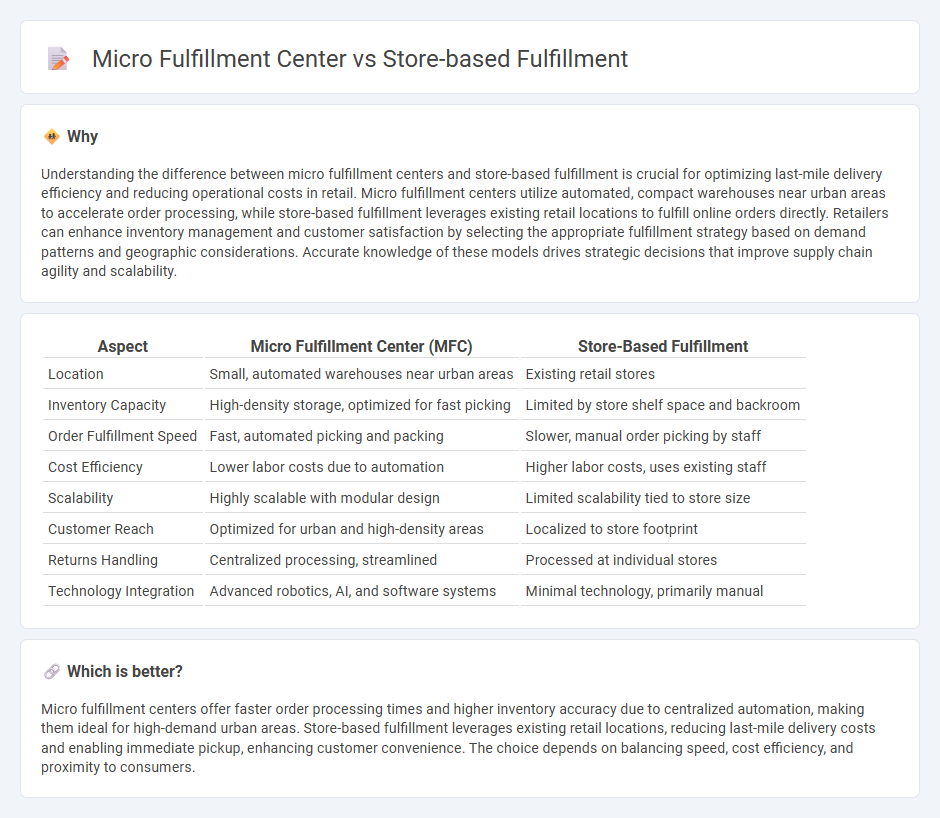
Micro fulfillment centers optimize order processing by using automation and strategically located small warehouses near urban areas, reducing delivery times and costs. Store-based fulfillment leverages existing retail locations to pick and ship orders, enhancing inventory turnover but often facing limitations in space and efficiency. Explore more to understand which fulfillment strategy best suits your retail business needs.
Why it is important
Understanding the difference between micro fulfillment centers and store-based fulfillment is crucial for optimizing last-mile delivery efficiency and reducing operational costs in retail. Micro fulfillment centers utilize automated, compact warehouses near urban areas to accelerate order processing, while store-based fulfillment leverages existing retail locations to fulfill online orders directly. Retailers can enhance inventory management and customer satisfaction by selecting the appropriate fulfillment strategy based on demand patterns and geographic considerations. Accurate knowledge of these models drives strategic decisions that improve supply chain agility and scalability.
Comparison Table
| Aspect | Micro Fulfillment Center (MFC) | Store-Based Fulfillment |
|---|---|---|
| Location | Small, automated warehouses near urban areas | Existing retail stores |
| Inventory Capacity | High-density storage, optimized for fast picking | Limited by store shelf space and backroom |
| Order Fulfillment Speed | Fast, automated picking and packing | Slower, manual order picking by staff |
| Cost Efficiency | Lower labor costs due to automation | Higher labor costs, uses existing staff |
| Scalability | Highly scalable with modular design | Limited scalability tied to store size |
| Customer Reach | Optimized for urban and high-density areas | Localized to store footprint |
| Returns Handling | Centralized processing, streamlined | Processed at individual stores |
| Technology Integration | Advanced robotics, AI, and software systems | Minimal technology, primarily manual |
Which is better?
Micro fulfillment centers offer faster order processing times and higher inventory accuracy due to centralized automation, making them ideal for high-demand urban areas. Store-based fulfillment leverages existing retail locations, reducing last-mile delivery costs and enabling immediate pickup, enhancing customer convenience. The choice depends on balancing speed, cost efficiency, and proximity to consumers.
Connection
Micro fulfillment centers leverage store-based fulfillment by integrating small-scale automated warehouses within or near retail locations to expedite order processing and reduce last-mile delivery costs. This connection enhances inventory accuracy and ensures faster replenishment by synchronizing in-store stock with micro fulfillment operations. Retailers benefit from improved customer satisfaction through quicker order fulfillment and optimized supply chain efficiency.
Key Terms
Inventory management
Store-based fulfillment relies on inventory stored directly in retail locations, enabling rapid order processing and local stock visibility but often faces challenges with limited space and inventory accuracy. Micro fulfillment centers operate as compact, automated warehouses near urban areas, optimizing inventory management through advanced robotics and real-time data, increasing efficiency and order accuracy. Explore the differences in inventory strategies and technological integration to further understand which fulfillment model suits your business needs.
Order picking efficiency
Store-based fulfillment relies on existing retail locations, often leading to longer picking times due to store layout and concurrent customer browsing, impacting order picking efficiency. Micro fulfillment centers (MFCs) utilize automated systems and optimized storage designs in small, dedicated spaces near urban areas, significantly accelerating order picking and reducing errors. Explore the benefits of micro fulfillment centers and their impact on enhancing order picking efficiency for modern retail operations.
Last-mile delivery
Store-based fulfillment leverages existing retail locations to fulfill online orders, enabling faster last-mile delivery through proximity to customers and reducing shipping costs. Micro fulfillment centers (MFCs) are smaller, automated warehouses positioned closer to urban areas, optimizing inventory management and increasing order processing speed for last-mile delivery efficiency. Explore how these fulfillment models impact delivery speed and customer satisfaction in evolving urban logistics.
Source and External Links
Is ship from store fulfillment right for your retail business? - Ryder - Ship from store fulfillment is a store-based method where retail stores use on-hand inventory to pick, pack, and ship online orders directly to customers, turning storefronts into omnichannel fulfillment centers.
In-Store Fulfillment - Deck Commerce - In-store fulfillment uses physical stores as fulfillment centers by leveraging inventory, staff, and space to pick, pack, and ship orders, with smart order routing and real-time inventory visibility to optimize customer proximity and order accuracy.
How Retailers Can Benefit From Turning Stores into eCommerce Fulfillment Centers - Store-based ecommerce fulfillment lowers last-mile delivery costs, improves inventory management through real-time OMS visibility, and speeds up order processing by using store staff and space for picking, packing, and shipping online orders.
 dowidth.com
dowidth.com